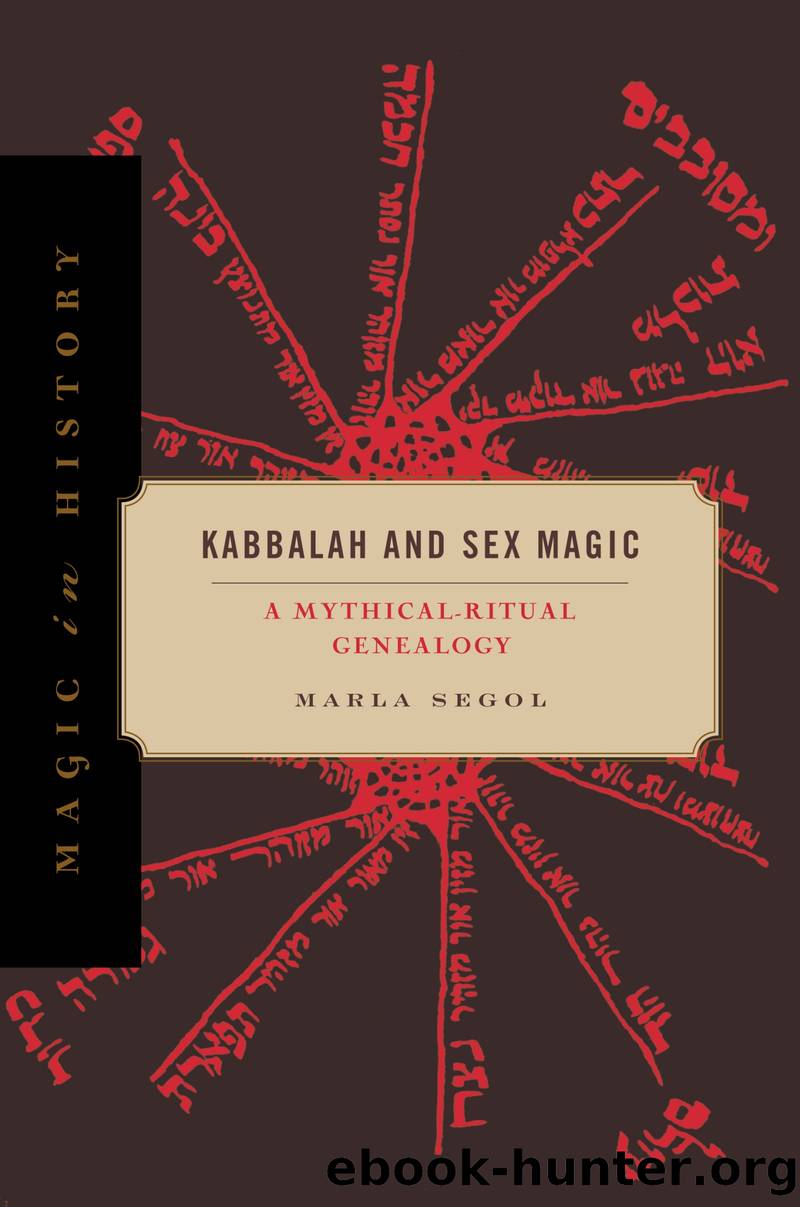Kabbalah and Sex Magic by Marla Segol

Author:Marla Segol
Language: eng
Format: epub
Publisher: Penn State University Press
The Letters
Verses 11â28 (15â44) gender the letters of the Sefer Yetsirah to show them creating human beings by means of sexual reproduction. In the Sefer Yetsirah, the Hebrew letters play a crucial role in articulating the main ideas of this first layer. They, too, are embodied, gendered (and bi-gendered), and generative. Drawing upon earlier images, verses 11â28 (15â44) describe the use of letters to create human beings by means of sexual reproduction, showing a microcosmic and substantial relationship between human and divine bodies. These verses use the letters to transfer the eroticism of the relationship between God and the heart to that between human and divine, depicting intimate and sexualized relations between God, Godâs heart, and the human being. In the Bahir, both human and divine bodies are constructed of letters, such that they are substantially connected. At the same time, the text describes an expansive body that encompasses various levels within its frame. At its center is the heart, which will later become the birthplace of letters, the sefirot, and wisdom. In verse 8 (10), the text asks, âWhat is the meaning of âfrom eternityâ (me-olam)? This means that it must be concealed from the world (he-elam). It is thus written: (Ecc 3:11) He has also placed the world in their hearts [that they should not find out the work that God has done from the beginning to the end.] Do not read HaOlam, but HeElam.â43 Thus we see the human heart embodying first the world and then knowledge of divine creation. The heart encompasses the world, which at first prevents knowledge of the divine but then gives way to it.
Earlier verses assert that Abrahamâs and Godâs bodies are structurally alike and composed of letters. Verse 11 (15) develops this concept as it discusses the sexualized mode of their creation by letters: âWhat does the Bet resemble? It is like a man, formed by God with wisdom. The Alef, however, is open from behind. This teaches us that the tail of the Bet is open from behind. If not for this, man could not exist. Likewise, if not for the bet on the tail of the aleph, the world could not exist.â44 This shows the letters, first of all, sharing substance by means of encompassmentâthe bet is within the aleph. This relationship of encompassment, according to Elliot Wolfson, is a key feature of early theosophy.45 Both letters are also open; the bet is open so that man can exist and the aleph so that the world can exist. This is clearly a narrative of creation by sexual reproduction, of the human being through the opening in the bet, the world through the opening in the aleph. The gendering here is flexibleâboth the male and the female letters have reproductive openings.46
Subsequent passages develop this notion to assert something more radicalâthat God is a man and that letters also constitute the divine body. Verse 18 (26) glosses Exodus 15:3, describing God as an ish Milchamah, or man of war:
Rabbi Amorai said:
Download
This site does not store any files on its server. We only index and link to content provided by other sites. Please contact the content providers to delete copyright contents if any and email us, we'll remove relevant links or contents immediately.
THEM: They Come at Night by Tom Lyons(169)
The Return of the Dragon : The Shocking Way Drugs and Religion Shape People and Societies by Lewis Ungit(155)
Cult Cinema: A Personal Exploration of Sects, Brainwashing and Bad Religion in Film and Television by Ingham Howard(149)
101 Ways to Jump-Start Your Intuition by John Holland(146)
The Mind at Large: Clairvoyance, Psychics, Police and Life after Death: A Polish Perspective by Weaver Zofia & Janoszka Krzysztof(143)
Evil Unleashed: True Tales of Spells Gone to Hell and Other Occult Disasters by John Harker(129)
Kabbalah and Sex Magic by Marla Segol(128)
Strange Tricks by Syd Moore(127)
Dogme et Rituel de la Haute Magie Part I by Eliphas Levi(127)
Psychic Secrets by Jade-Sky(121)
The Ghost Hunter's MOST HAUNTED Box Set (3 in 1) by Terrance Zepke(121)
The Iron Republic by Richard Jameson Morgan(121)
The A-Z of Curious London by Gilly Pickup(119)
Kickstart My Witch (Witch's Guide to Haunted Properties: Los Angeles: Mystery Book 1) by Lotta Smith(119)
The Airmen Who Would Not Die by Fuller John G(114)
The Folk-Tales of the Magyars by Unknown(112)
Supernatural: Your Guide Through the Unexplained, the Unearthly and the Unknown by Colin Wilson(105)
The Satanism Scare by Joel Best(104)
A Brief Guide to Ghost Hunting by Leo Ruickbie(99)
